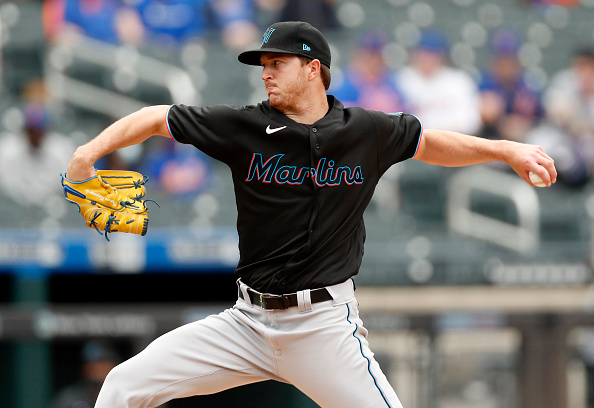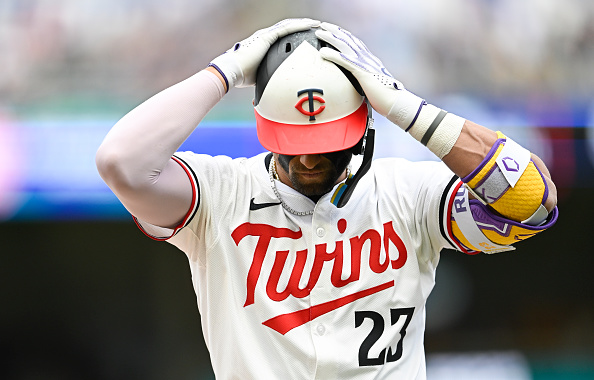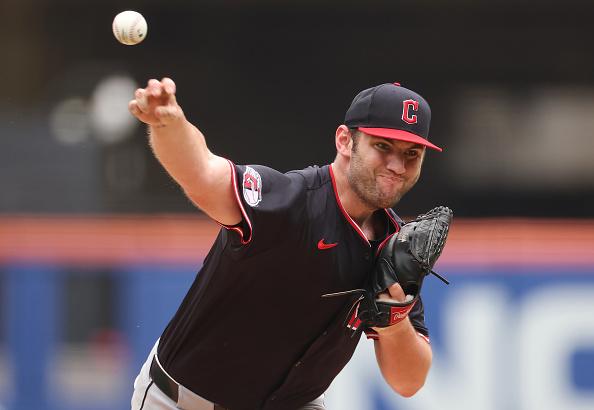In the first month of the 2021 season, the top-two pitchers in baseball have been Jacob deGrom and Corbin Burnes, and that is not really up for debate. The two have excelled in nearly every start they have made this year, limiting walks while picking up strikeouts left-and-right. Burnes and deGrom do have something in common; both teams lost to the Miami Marlins. It is unfair to deGrom, as he struck out 14 and allowed one run while his offense could not come through, but it was a loss nevertheless.
In their wins against the two aces, the Marlins allowed a combined zero runs. Who was their starting pitcher in those two games? It was Trevor Rogers. For those who were previously unaware of Rogers, it may be time that to start paying attention to this 23-year-old.
Highly Touted Youngster
Rogers is a big left-hander, standing six-foot-five out of Carlsbad, NM. He is already on track to be the best starting pitcher in MLB history from the state, as the competition is Wade Blasingame and a couple of swingmen. The only other notable pitcher in baseball from the state is Ken Giles, who is out for the season.
Rogers was good enough in High School that he was drafted 13th overall by Miami in 2017. In his first minor league season at Single-A Greensboro, Rogers was off, with a 5.82 earned run average in 17 starts. He rebounded at High-A the next year, with a 2.53 ERA in 18 outings. Entering 2020, MLB Pipeline ranked Rogers as the ninth-best prospect in the Marlins organization.
Despite having just five starts at Double-A and none at Triple-A, the Marlins called up Rogers during their COVID-19 crisis last year. In his 28 innings pitched, his lack of minor league experience showed. Rogers had a 6.11 ERA while allowing 32 hits with 13 walks and two hit-by-pitches for a 1.607 WHIP. These struggles made Rogers not a lock to make the team’s rotation out of Spring Training.
But was he really that bad?
Expected Numbers
Despite that very high 6.11 ERA, Rogers’ expected ERA (xERA) was a very solid 3.53. That would put him in the range of Miami’s top starters from last year, Sandy Alcantara (3.00), Pablo Lopez (3.61), and Sixto Sanchez (3.46).
The reason for Rogers’ improved xERA is his high strikeout rate. In those 28 innings, he struck out 39 batters while allowing just four barrels. He also had an average exit velocity of 87.3 mph, which placed him in the 68th percentile of pitchers. His numbers also showed that Rogers was getting unlucky with his main pitches. He is a fastball pitcher, throwing the heater over half of the time last year. Batters had a batting average of .314 with a .627 slugging versus the pitch. But, the expected average and slugging were just .195 and .344, respectively.
His slider was in a similar boat as his fastball, and Rogers’ changeup became his best pitch. It finished off 11 of his strikeouts, with a 35.3 percent whiff rate, higher than his other three pitches (the fourth is a sinker, but he barely throws it). Rogers’ other pitches have below-average vertical movement, but his changeup does not fit in that category, at 5.8 inches above average. It also has 1.8 inches above average horizontally. The fastball has 6.1 in that category. So while the numbers were not fully there yet, the then-22-year-old still did enough to make Marlins fans have something to look forward to. This April, he has delivered on that.
Offseason Improvements
The most striking difference between 2020 Rogers and 2021 Rogers is the usage and velocity of his fastball. The average velocity on it was 93.6 miles per hour in 2020. That is not awful, but it isn’t anything to get interested in. In his five starts this year, that has significantly risen; it is up to 95 mph. As he gets ramped up further, that can go up. In his most recent start against Milwaukee on Monday, Rogers hit 97+ mph on three separate occasions, making him much more of a power threat. Taking advantage of it, Rogers has raised his fastball usage rate from 54.2 up to 62.7 percent.
The changeup is still a very effective pitch this year. It may be averaging a moderately high 86.6 miles per hour, but its incredibly low 1488 rpm average spin rate makes the pitch fall more and leads to it being effective with tons of movement.
Putting It Together
Rogers’ new and improved fastball gave him a better chance to succeed this year, and it is working out thus far. Not only has he hit the numbers expected of him last year, but he has also moved into a different atmosphere. Entering Tuesday, he had a 1.29 ERA. He has allowed just 18 hits in 28 innings while striking out 38. That is the same amount of innings pitched as he had all of last year, and while he has struck out one less batter, allowing 14 fewer hits, three fewer walks, and a WHIP .607 better, at exactly 1.000. And still, his 12.2 K/9 is very good for a starting pitcher.
On a pitch-to-pitch basis, Rogers’ actual numbers are coming much closer to expected than they did last year. The 119 point difference in fastball average is gone. Now, it is zero. That’s right; Rogers has an xBA of .175 against the fastball, and hitters have a .175 average against it right now, as well. The slugging and xSLG are also very similar with a 17 point difference. Expected numbers suggest that Rogers should actually be better, with batters expected to slug .253 against the fastball, and not .270.
His pitches are all seeing very good whiff rates this year. While only the changeup was above 35 percent last year, all three of Rogers’ main pitches are over that plateau at the moment. It may only have been thrown 73 times, but the slider is the clubhouse leader at 40.7 percent.
The changeup was his best pitch last year, and it is still tops with Rogers. Batters are hitting .160 with a .200 slugging percentage against the pitch, plus a .175 xBA and a .281 xSLG. Just like last year, the pitch is great at forcing soft contact. Batters have just an 85.7 mph average exit velocity against it.
Rogers has actually shown reverse splits as a southpaw. While lefties have a .316 average against him in 19 at-bats, right-handers have looked helpless at the plate. In 87 Plate Appearances, Rogers has limited them to a .156 average and a .469 OPS. That is a massive improvement on last year when Rogers allowed righties to have a .902 OPS against him.
Finally, while it should be self-explanatory already, Rogers’ success is allowing him to go deeper into games. He made seven starts in 2020 and averaged just four innings an outing. He is over five innings per game this year. This allows the Marlins to get their bullpen more rest and gives Manager Don Mattingly more options.
Check us out on our socials:
Twitter: @PTSTNews and @TalkPrimeTime
Facebook Page: Prime Time Sports Talk
Join our Facebook Group: Prime Time Sports Talk
Instagram: @ptsportstalk
Follow Carter LaCorte on Twitter @CarterHudBlog
Main Image Credit:
Embed from Getty Images








One Response